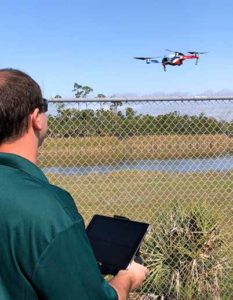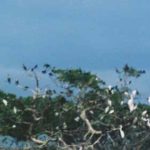A New Weapon to Fight the Bite: Drones

Patrick Linn, MS, MSHAPI
Executive Director, Collier Mosquito Control District
The buzzing you hear near a water filled ditch in Collier County today may not be a swarm of mosquitoes seeking their next meal. Instead, it may be the whirring propellers of a Collier Mosquito Control District drone equipped with sophisticated cameras and software on the hunt for the bloodsuckers.
The ability to locate mosquito breeding grounds and larvae is a year-round component of the District’s surveillance. Scouting for active mosquito egg-laying sites on foot is both laborious and sometimes hazardous; the water-filled landscapes are better viewed from the air. Until now, the District has used its helicopters for aerial surveillance missions to both map the habitat and apply larvicide treatment missions.
Today, drones outfitted with high-definition cameras are making geographic surveillance more efficient and economical. In terms of scope, the drone fleet are greatly augmenting both the accuracy and extent of our surveillance of hard-to-reach areas. We are able to quantitatively assess and map the Collier County landscape for standing water and mosquito larvae with a variety of drones. Pilots view and record images and video from a bird’s-eye perspective, allowing a superior real time view of surface water, chlorophyll status of plants, and geographic features.
The “Splash Drone” lands directly in the water with its waterproof camera, providing an underwater live view of larvae in  the area. Nine District employees have passed the FAA Remote Pilot in Command Certification Exam, earning their licenses to operate drones. By the end of this summer, the District will receive certification for larvicide distribution using a larger drone quipped to carry 13 pounds of granular larvicide. Its nimble operations, compact size, and payload make it the perfect tool to treat smaller areas up to 10 acres at a time, versus sending a helicopter to apply the larvicide.
the area. Nine District employees have passed the FAA Remote Pilot in Command Certification Exam, earning their licenses to operate drones. By the end of this summer, the District will receive certification for larvicide distribution using a larger drone quipped to carry 13 pounds of granular larvicide. Its nimble operations, compact size, and payload make it the perfect tool to treat smaller areas up to 10 acres at a time, versus sending a helicopter to apply the larvicide.
Targeting mosquito larvae with larvicide applications is one of the basic tenets of integrated mosquito management, and last year the District increased its use of larvicides by 260 percent. We are quickly finding that these new tools are providing savings in time and cost of surveillance when compared to traditional ground and aerial methods. Best of all, the buzz of a drone is considerably less intrusive than that of a much larger helicopter.
 To learn more about the District’s operations, public tours are available. Included are presentations by our research team in the laboratory, our operations/surveillance team, and a visit to the hangar. We also make arrangements for staff to conduct presentations at group meetings. Please call our office at (239) 436-1000 to schedule a tour or if we can provide more information.
To learn more about the District’s operations, public tours are available. Included are presentations by our research team in the laboratory, our operations/surveillance team, and a visit to the hangar. We also make arrangements for staff to conduct presentations at group meetings. Please call our office at (239) 436-1000 to schedule a tour or if we can provide more information.



Leave a Reply
Want to join the discussion?Feel free to contribute!